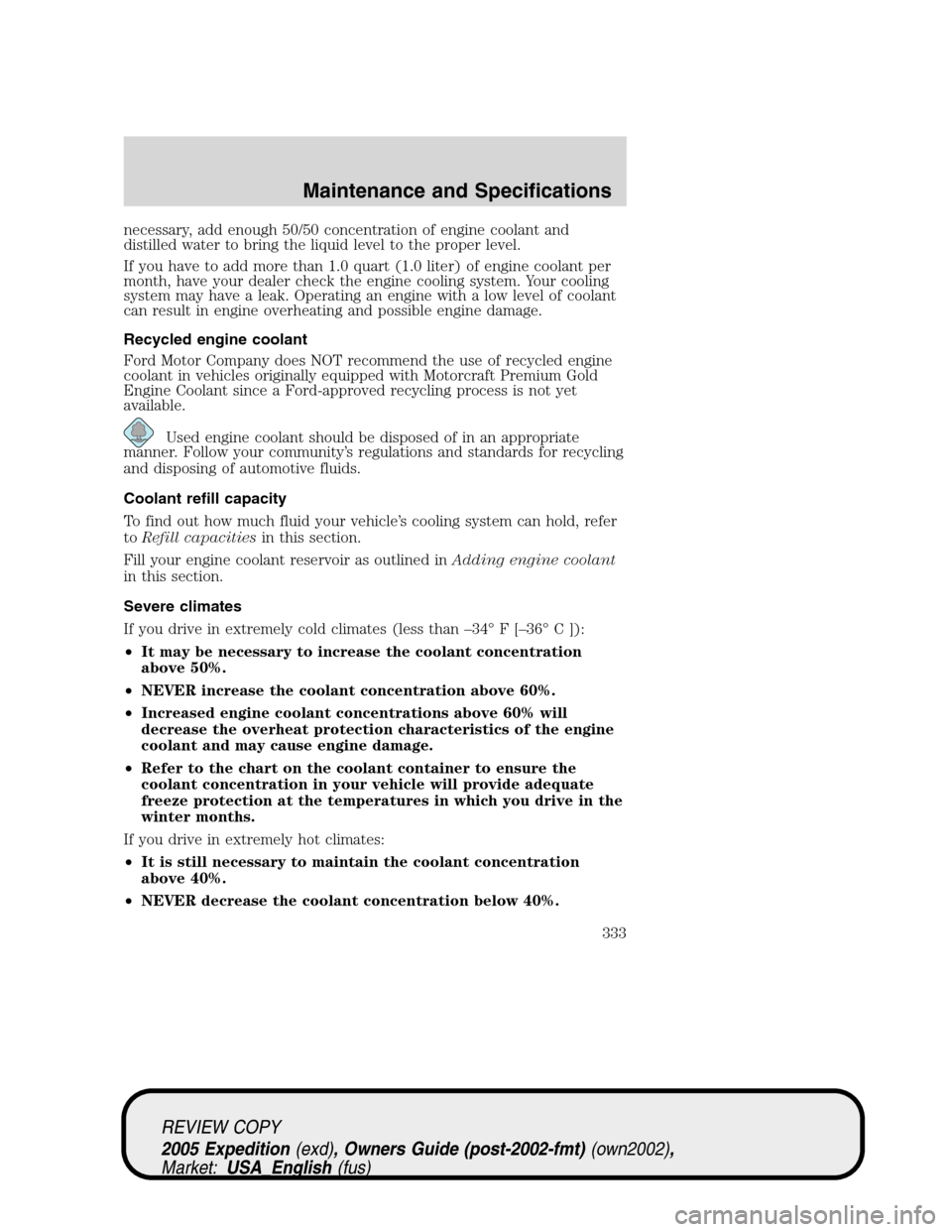Page 333 of 368

necessary, add enough 50/50 concentration of engine coolant and
distilled water to bring the liquid level to the proper level.
If you have to add more than 1.0 quart (1.0 liter) of engine coolant per
month, have your dealer check the engine cooling system. Your cooling
system may have a leak. Operating an engine with a low level of coolant
can result in engine overheating and possible engine damage.
Recycled engine coolant
Ford Motor Company does NOT recommend the use of recycled engine
coolant in vehicles originally equipped with Motorcraft Premium Gold
Engine Coolant since a Ford-approved recycling process is not yet
available.
Used engine coolant should be disposed of in an appropriate
manner. Follow your community’s regulations and standards for recycling
and disposing of automotive fluids.
Coolant refill capacity
To find out how much fluid your vehicle’s cooling system can hold, refer
toRefill capacitiesin this section.
Fill your engine coolant reservoir as outlined inAdding engine coolant
in this section.
Severe climates
If you drive in extremely cold climates (less than –34° F [–36° C ]):
•It may be necessary to increase the coolant concentration
above 50%.
•NEVER increase the coolant concentration above 60%.
•Increased engine coolant concentrations above 60% will
decrease the overheat protection characteristics of the engine
coolant and may cause engine damage.
•Refer to the chart on the coolant container to ensure the
coolant concentration in your vehicle will provide adequate
freeze protection at the temperatures in which you drive in the
winter months.
If you drive in extremely hot climates:
•It is still necessary to maintain the coolant concentration
above 40%.
•NEVER decrease the coolant concentration below 40%.
REVIEW COPY
2005 Expedition(exd), Owners Guide (post-2002-fmt)(own2002),
Market:USA_English(fus)
Maintenance and Specifications
333
Page 334 of 368

•Decreased engine coolant concentrations below 40% will
decrease the corrosion protection characteristics of the engine
coolant and may cause engine damage.
•Decreased engine coolant concentrations below 40% will
decrease the freeze protection characteristics of the engine
coolant and may cause engine damage.
•Refer to the chart on the coolant container to ensure the
coolant concentration in your vehicle will provide adequate
protection at the temperatures in which you drive.
Vehicles driven year-round in non-extreme climates should use a 50/50
mixture of engine coolant and distilled water for optimum cooling system
and engine protection.
What you should know about fail-safe cooling
If the engine coolant supply is depleted, this feature allows the vehicle to
be driven temporarily before incremental component damage is incurred.
The “fail-safe” distance depends on ambient temperatures, vehicle load
and terrain.
How fail-safe cooling works
If the engine begins to overheat:
•The engine coolant temperature
gauge will move to the red (hot)
area.
•CHECK ENGINE TEMPERATURE
will illuminate in the message
center.
•TheService engine soonindicator light will illuminate.
If the engine reaches a preset over-temperature condition, the engine
will automatically switch to alternating cylinder operation. Each disabled
cylinder acts as an air pump and cools the engine.
When this occurs the vehicle will still operate. However:
•The engine power will be limited.
•The air conditioning system will be disabled.
Continued operation will increase the engine temperature:
•The engine will completely shut down.
•Steering and braking effort will increase.
CH
REVIEW COPY
2005 Expedition(exd), Owners Guide (post-2002-fmt)(own2002),
Market:USA_English(fus)
Maintenance and Specifications
334
Page 364 of 368

recommendations ...................326
refill capacities ........................351
specifications ..................353, 356
Exhaust fumes ..........................258
F
Fail safe cooling ........................334
Floor mats .................................146
Fluid capacities .........................351
Foglamps ...................................102
Four-Wheel Drive vehicles .......275
control trac .............................275
description ..............................276
driving off road .......................278
electronic shift ........................277
indicator light .........................275
preparing to drive your
vehicle .....................................264
Fuel ............................................335
calculating fuel economy ......137,
339
cap ...........................................337
capacity ...................................351
choosing the right fuel ...........338
comparisons with EPA fuel
economy estimates .................342
detergent in fuel .....................339
filling your vehicle
with fuel ..................335, 337, 340
filter, specifications ........339, 350
fuel pump shut-off switch .....287
improving fuel economy ........339
octane rating ...................338, 356
quality ......................................339
running out of fuel .................339
safety information relating to
automotive fuels .....................335
Fuses ..................................288, 290G
Garage Door Opener (see
Homelink wireless control
system) ......................................128
Gas cap (see Fuel cap) ............337
Gas mileage (see
Fuel economy) ..........................339
Gauges .........................................14
H
Hazard flashers .........................287
Headlamps .................................102
aiming ......................................104
autolamp system .....................102
bulb specifications ..................107
daytime running lights ...........103
flash to pass ............................103
high beam ...............................103
replacing bulbs .......................108
turning on and off ..................102
Heating
heating and air
conditioning system ...........92, 96
Homelink wireless control
system ........................................128
Hood ..........................................322
I
Ignition ...............................255, 356
Infant seats (see
Safety seats) .............................201
Inspection/maintenance
(I/M) testing ..............................344
Instrument panel
cleaning ...................................318
cluster ........................................10
REVIEW COPY
2005 Expedition(exd), Owners Guide (post-2002-fmt)(own2002),
Market:USA_English(fus)
Index
364